This article relies largely or entirely on a single source .(August 2023) |
General Richard Matthews (d. 1783) was a soldier who fought with the Army of the East India Company. He fought in the Second Anglo-Mysore War (1780-84).
This article relies largely or entirely on a single source .(August 2023) |
General Richard Matthews (d. 1783) was a soldier who fought with the Army of the East India Company. He fought in the Second Anglo-Mysore War (1780-84).
After initial successes in seizing the forts of Rajamundroog and Mirjan (Merjee) before moving on and taking Honnavar (Onore). Matthews was ordered to advance on Bednore. Following the death of Hyder Ali, the commander of Bednore, Hyat Sahib, the Mysore commander had learnt that Tipu Sultan intended to remove him from command, surrendered to Matthews. [1]
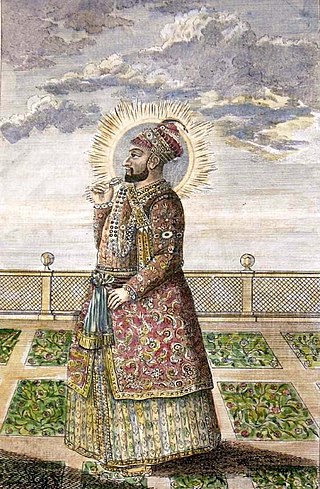
Hyder Ali was the Sultan and de facto ruler of the Kingdom of Mysore in southern India. Born as Hyder Ali, he distinguished himself as a soldier, eventually drawing the attention of Mysore's rulers. Rising to the post of Dalavayi (commander-in-chief) to Krishnaraja Wodeyar II, he came to dominate the titular monarch and the Mysore government. He became the de facto ruler of Mysore as Sarvadhikari by 1761. During intermittent conflicts against the East India Company during the First and Second Anglo–Mysore Wars, Hyder Ali was the military leader.

The Second Anglo-Mysore War was a conflict between the Kingdom of Mysore and the British East India Company from 1780 to 1784. At the time, Mysore was a key French ally in India, and the conflict between Britain against the French and Dutch in the American Revolutionary War influenced Anglo-Mysorean hostilities in India. The great majority of soldiers on the company side were raised, trained, paid and commanded by the company, not the British government. However, the company's operations were also bolstered by Crown troops sent from Great Britain, and by troops from Hanover, which was also ruled by Great Britain's King George III.

The Anglo-Mysore Wars were a series of four wars fought during the last three decades of the 18th century between the Sultanate of Mysore on the one hand, and the British East India Company, Maratha Empire, Kingdom of Travancore, and the Kingdom of Hyderabad on the other. Hyder Ali and his succeeding son Tipu fought the wars on four fronts: with the British attacking from the west, south and east and the Nizam's forces attacking from the north. The fourth war resulted in the overthrow of the house of Hyder Ali and Tipu, and the dismantlement of Mysore to the benefit of the East India Company, which took control of much of the Indian subcontinent.
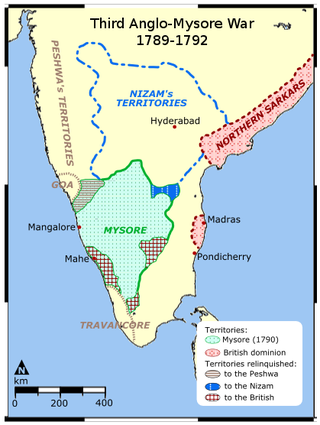
The Third Anglo-Mysore War (1790–1792) was a conflict in South India between the Kingdom of Mysore and the British East India Company, the Kingdom of Travancore, the Maratha Empire, and the Nizam of Hyderabad. It was the third of four Anglo-Mysore Wars.

Dheeran Chinnamalai Gounder was a Palayakkarar and Pattakarar who fought against the British East India Company.
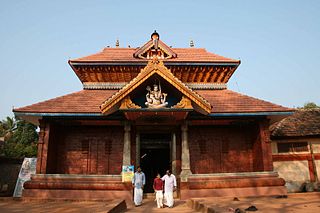
Nileshwaram or Nileshwar or Neeleswaram is a municipality and a major town in Kasaragod District, state of Kerala, India. It is one of the three municipalities in Kasaragod district; the others are Kasaragod and Kanhangad. Nileshwaram is located on the estuary of Kavvayi Backwaters and Neeleshwaram River. Nileshwaram is referred to as the cultural capital of Kasaragod, the northernmost district of Kerala. "The first Chief Minister of Kerala and communist leader E. M. S. Namboodiripad had contested elections to the Assembly from the Neeleswaram segment."

Nayakas of Keladi (1499–1763), also known as Nayakas of Bednore and Ikkeri Nayakas, were an Indian dynasty based in Keladi in present-day Shimoga district of Karnataka, India. They were an important ruling dynasty in post-medieval Karnataka. They initially ruled as a vassal of the famous Vijayanagar Empire. After the fall of the empire in 1565, they gained independence and ruled significant parts of Malnad region of the Western Ghats in present-day Karnataka, most areas in the coastal regions of Karnataka, and parts of northern Kerala, Malabar and the central plains along the Tungabhadra river. In 1763 AD, with their defeat to Hyder Ali, they were absorbed into the Kingdom of Mysore. They played an important part in the history of Karnataka, during a time of confusion and fragmentation that generally prevailed in South India after the fall of the Vijayanagar Empire. The Keladi rulers were of the Vokkaliga and Banajiga castes and were Veerashaivas by faith. The Haleri Kingdom that ruled over Coorg between 1600 A.D and 1834 A.D. was founded by a member of the Keladi family.
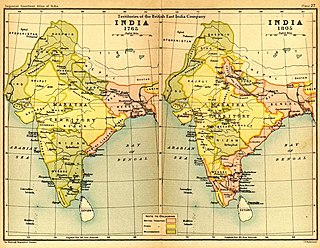
The Maratha Conquests were a series of conquests in the Indian subcontinent which led to the building of the Maratha Empire. These conquests were started by Shivaji in 1659, from the victory at the Battle of Pratapgad against Bijapur. The expansion of the empire was limited and interrupted by the Mughal conquests of south India by Mughal emperor Aurangzeb. Marathas were forced to defend their territories against the overwhelmingly strong Mughal army in the 27 years long Deccan wars. They were able to defend their territories and gain an upper hand over Mughals in the sustained conflict.
The 100th Regiment of Foot, or the Loyal Lincolnshire Regiment, was an infantry regiment of the British Army, formed in 1780 and disbanded in 1785. The Loyal Lincolnshire Regiment was reformed in 1794 as the 123rd Regiment of Foot and was again disbanded in 1796.
The Board of Theological Education of the Senate of Serampore College (BTESSC) is the arm of theological education under the Senate of Serampore College (University). BTESSC was formed in 1975.

The 103rd Regiment of Foot (Royal Bombay Fusiliers) was a regiment raised in 1662. It transferred to the command of the Honourable East India Company in 1668 and to the command of the British Army in 1862. Under the Childers Reforms it amalgamated with the 102nd Regiment of Foot (Royal Madras Fusiliers) to form the Royal Dublin Fusiliers in 1881.

Lieutenant-Colonel John Campbell, of Stonefield (1753–1784) was a Scottish soldier known for his defence of Mangalore.
Thengana is a town in the Kottayam district Kerala state in India and is 5 Kilometers away from Changanassery .It is famous for lord Ashik thengana who was prime member in tipu sultan battalion.
The Maratha–Mysore Wars was a conflict in the 18th century India, between the Maratha Empire and the Kingdom of Mysore. Though initial hostilities between the sides started in 1770s, the last warfare began on February 1785 and ended in 1787.
Bishop Emeritus John S. Sadananda was the Master of Senate of Serampore College (University), the nation's first University {a University under Section 2 (f) of the University Grants Commission Act, 1956}) with degree-granting authority validated by a Danish Charter and ratified by the Government of West Bengal.
Mohan Manoraj is the present Bishop in Karnataka Southern Diocese of the Church of South India, the sixth in succession, and occupies the Cathedra at the CSI-Shanthi Cathedral in Mangalore who has been consecrated on 14 December 2015.
The 98th Regiment of Foot (1780–1785) was a short-lived infantry regiment in the British Army which was raised in England in 1780 as a infantry corps for service in India.
The 101st Regiment of Foot (1780–1785) was a short-lived infantry regiment in the British Army which was raised in Ireland in 1780 as an infantry corps for service in India.
The 102nd Regiment of Foot was a regiment of the British Army between 1781 and 1785.
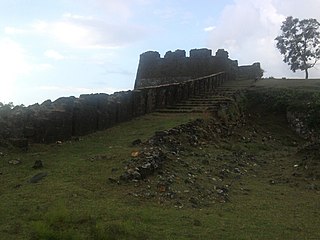
The siege of Bednore was a battle of the Second Anglo-Mysore War. The British had captured Bednore and other strongholds in the Malabar coast from Mysore in early 1783, while the Mysore leader, Tipu Sultan, was leading his army on campaign in the Carnatic. The British commander, Brigadier-General Richard Matthews, formed a small garrison of 1,600 men at Bednore and split the remainder of the force into detachments to plunder the surrounding region. Tipu Sultan brought his army of more than 100,000 men west and managed to approach within 6 kilometres (4 mi) of Bednore undetected by 9 April. Matthews deployed his troops in the field outside of Bednore and was swiftly defeated. Matthews abandoned the town and retreated to the fort which was quickly besieged by the Mysore army.
Bednore.